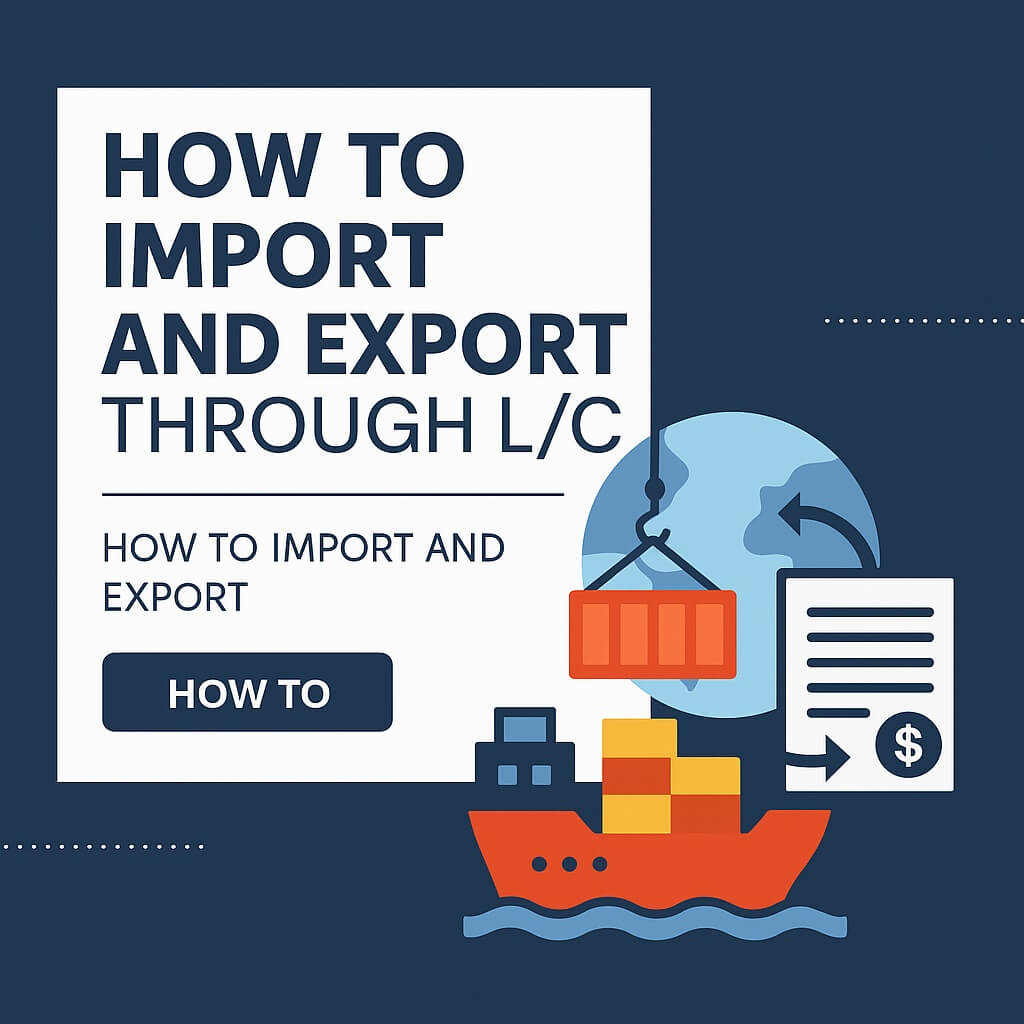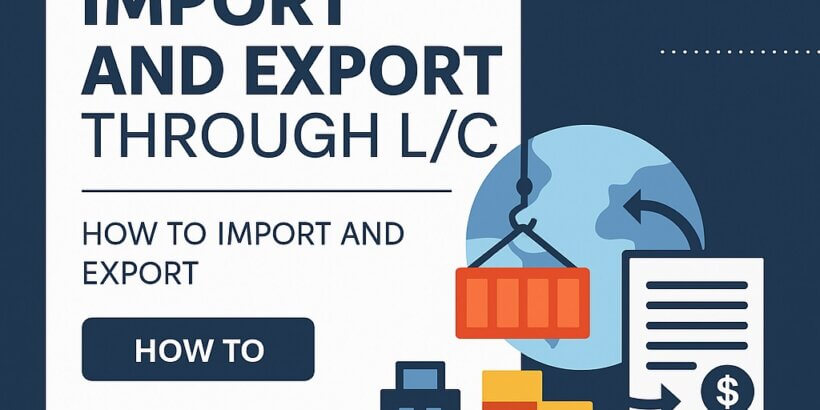How to import and Export through L/C
Key point of Discussion
Workshop on “ How to import and Export through L/C ”
General Concept About Foreign Exchange Operation
Concept of Foreign Exchange
Local Regulation for Foreign Exchange
Foreign Exchange Regulation Act
Guideline for Foreign Exchange Transaction
Foreign Exchange Circular
Export Import Policy
Public Notice
Instruction from different Ministry
International Regulations for Foreign Exchange
World Trade Organization (WTO)
International Chamber of Commerce(ICC)
UCPDC 600
URR ICC Publication 525
UR for collection ICC Publication 522
INCO Terms 2000
International Standard Banking Practice (ISBP)
Authorized Dealer
License of Authorized Dealer
Function of Authorized Dealer
Foreign Exchange Market
Types of Foreign Exchange Market
Term used in Foreign Exchange Market operation
Trade Transaction
Method of Foreign Trade Payment
Bank’s Involvement in Foreign Trade
L/C Operation
Type of L/C
Parties are involved in L/C Operation
Flow Chart of L/C Operational Mechanism
Documents involved in L/C
Foreign Correspondent
Foreign Correspondent Relationship
Accounting Relationship
Exchange Rate and Their Application
Foreign Exchange Business of SIBL
A. Import Section:
An overview of Import Business
Import Policy Order
Classification of Importer
Registration of Importer
Problem to Obtain IRC
Import Flowchart
Operational Mechanism of Import Section
How to Import and Export Through L/C (Letter of Credit)
A Letter of Credit (L/C) is one of the most common and safest methods used in international trade to ensure payment between importers (buyers) and exporters (sellers). It acts as a payment guarantee from the buyer’s bank to the seller, provided the seller meets all terms and conditions mentioned in the L/C.
What Is a Letter of Credit (L/C)?
A Letter of Credit (L/C) is a financial instrument issued by a bank (importer’s bank) on behalf of the buyer, promising to pay the seller (exporter) a specified amount once the seller presents documents proving shipment as per agreed terms.
✅ Example:
A company in Bangladesh (importer) wants to buy electronics from Japan (exporter). Instead of paying directly, the importer asks its bank to issue an L/C. The bank promises to pay the Japanese company once the shipment documents are provided.
Key Parties Involved in L/C
| Party | Role |
|---|---|
| Importer (Applicant) | Requests the L/C from its bank |
| Issuing Bank | Issues the L/C on behalf of the importer |
| Exporter (Beneficiary) | Receives payment under the L/C |
| Advising Bank | The exporter’s bank that advises/forwards the L/C |
| Negotiating Bank (Optional) | Checks documents and pays the exporter |
| Confirming Bank (Optional) | Guarantees payment if issuing bank fails |
Step-by-Step Process: Import and Export Through L/C
Step 1: Sales Agreement Between Importer & Exporter
-
Both parties agree on trade terms (price, quantity, quality, delivery date, shipment method, Incoterms, etc.).
-
Payment terms are decided as Letter of Credit (L/C).
Tip: Always include L/C payment terms in the proforma invoice or sales contract.
Step 2: Importer Applies for L/C
-
Importer approaches their bank (issuing bank) with:
-
Proforma Invoice / Sales Contract
-
Import License (if required)
-
Tax documents, Trade license
-
Credit facility documents
-
-
Bank evaluates the importer’s creditworthiness.
✍️ Result: Bank issues an L/C in favor of the exporter.
Step 3: Issuing Bank Sends L/C to Advising Bank
-
The issuing bank (importer’s bank) transmits the L/C to the advising bank (exporter’s bank) via SWIFT.
-
Advising bank verifies authenticity and notifies the exporter.
Note: Exporter must carefully check all terms and conditions of the L/C. If any terms are unacceptable, they must request an amendment.
Step 4: Exporter Prepares Goods & Shipment
-
Exporter manufactures, packs, and ships goods as per contract.
-
Once goods are shipped, the exporter collects shipping and trade documents such as:
-
Bill of Lading / Air Waybill
-
Commercial Invoice
-
Packing List
-
Certificate of Origin
-
Insurance Certificate
-
Inspection Certificate (if required)
-
Step 5: Exporter Presents Documents to Bank
-
Exporter submits all required documents to the advising/negotiating bank.
-
Bank checks whether documents match the L/C terms (known as “document compliance”).
✅ If documents are compliant, the bank pays the exporter (or commits to pay at maturity in case of usance L/C).
❌ If documents are discrepant, the bank informs the exporter. Exporter must correct errors or request importer’s acceptance.
Step 6: Negotiating Bank Sends Documents to Issuing Bank
-
The negotiating/advising bank forwards the verified documents to the issuing bank.
-
The issuing bank reviews documents again and debits the importer’s account or arranges payment.
Step 7: Issuing Bank Delivers Documents to Importer
-
After payment (or acceptance), the issuing bank releases documents to the importer.
-
Importer uses these documents to clear goods from customs and take delivery.
Step 8: Settlement of Payment
-
Payment is made according to the type of L/C:
-
Sight L/C: Payment is made immediately upon document presentation.
-
Usance (Deferred) L/C: Payment is made after a specified period (e.g., 30, 60, or 90 days).
-
Example Scenario: Import through L/C
-
Contract: A company in Bangladesh agrees to import machinery from Germany for $100,000.
-
L/C Application: Importer’s bank issues an L/C to Germany’s advising bank.
-
Shipment: Exporter ships goods and provides documents.
-
Document Check: Advising bank verifies documents and pays exporter.
-
Payment & Delivery: Issuing bank pays and gives documents to importer.
-
Customs Clearance: Importer clears goods and receives shipment.
✅ Advantages of Using L/C
| For Importer | For Exporter |
|---|---|
| Payment only after shipment documents are received | Guaranteed payment from bank |
| Reduces risk of advance payment fraud | Financial security even if buyer defaults |
| Ensures compliance with trade terms | Helps in getting pre-shipment finance |
| Internationally recognized payment method | Builds trust and long-term trade relationships |
⚠️ Common Mistakes to Avoid
-
Not matching L/C terms with the sales contract.
-
Submitting incorrect or incomplete documents.
-
Ignoring expiry dates or shipment deadlines.
-
Choosing an unreliable bank or counterparty.
Types of Letters of Credit (L/C)
| Type | Meaning |
|---|---|
| Sight L/C | Payment made immediately on document presentation |
| Usance / Time L/C | Payment made after a specified time period |
| Confirmed L/C | Another bank guarantees payment if issuing bank defaults |
| Revocable L/C | Can be amended/cancelled without exporter’s consent (rare) |
| Irrevocable L/C | Cannot be changed without consent from all parties |
| Back-to-Back L/C | Exporter uses master L/C to open another L/C for supplier |
| Transferable L/C | Beneficiary can transfer credit to another party |
Quick Checklist for Importers and Exporters
✅ Importers:
-
Verify supplier credibility
-
Ensure correct L/C terms and conditions
-
Prepare sufficient funds/credit facility
-
Check all documents carefully before customs clearance
✅ Exporters:
-
Review L/C carefully before shipment
-
Ship goods exactly as per terms
-
Prepare flawless documentation
-
Submit documents within validity period
Final Thoughts
Using a Letter of Credit (L/C) is one of the safest and most widely accepted ways to conduct international trade. It minimizes risks for both importer and exporter, ensures compliance, and guarantees payment once conditions are met. However, success depends on accurate documentation, timely communication, and strict adherence to L/C terms.
Procedure of Opening Letter of Credit
1.Required docs. Submit by Importer
2.Collection information from Importer
3.Preperation of Credit Report
4.Required docs. provided by Bank
5.Cover Note with money receipt
6.Examination of L/C Application
7.Preperation of L/C Proposal
8.Numbering of L/C
9.Diposal of L/C
10.Pre-shpment Inspection
11.Charges
12.Amendment

Examination & Scrutiny of Import Documents:
Lodgement of Import Documents
Payment Settlement of Import L/C
Retirement of Import Documents
Reporting to Bangladesh Bank
B: Export Section
Export Business
Flow Char of Export (manufacturing)
Operational Mechanism of Export
Export L/C Checking & Advising
Obtaining Export Facilities from Bank
Lien of Master L/C
Procedure of Opening Back to Back L/C
Mechanism of Acceptance
Pre-shipment Financing
Negotiation of Export Documents
Post-Shipment Financing
Proceed Realization Procedure
Formalities of BTB L/C Payment
Formalities of BTB L/C Payment when export fails
Formalities of Buying House Commission Payment
EXP Form Reporting to Bangladesh Bank
Local Export Bill Purchasing & Discounting
C: Remittance Section
An overview of Foreign Currency Account
1.Private Foreign Currency Account
2. Required documents for Foreign Currency Account
3. Salient feature of Foreign Currency Account
4. Eligible person for Foreign Currency Account
5. Terms and conditions for Foreign Currency Account
6. Resident Foreign Currency Deposit Account
7. Convertible and non-Convertible Taka Account
8. Others A/C’s
Remittance
1. Procedure of inward remittance
a. Encashment of Traveler’s Cheque(T.C.)
b. Encashment of cash
c. Encashment of Draft and T.T.
d. Ways and methods of inward remittance
2. Procedure of outward remittance
a. Ways and methods of outward remittance
b. Ground of outward remittance
c. Issuance of Foreign Currency
WHO CAN PARTICIPATE
- Exporters and Importers
- Bankers, Insurance Personnel, Students
- Anyone who are interested
METHODOLOGY
- PowerPoint Presentation
- Interactive Discussion
v Question and Answer
Resource Person:
Md. Makhluk Hasan Ph.D (Banking)
Associate Fellow of IIBI, London,UK
Master of Demography,ISRT, DU
MBA(Finance & Banking),SMUCT
PGD (Islamic Banking & Insurance),IIBI, Dharhum University, London
Visiting Faculty: Newport University, EU ( Bangladesh Campus)
Venue :
BlackStone Institute, House No-13/A,Dhanmondi, Dhaka, Bangladesh
{ Tea break 10.30AM, Prayer and Launch break 12.45 PM to 1.45 PM, Tea break 4.00PM}
Note: Certificate and Booklet provided to all participant by the organizer.
Date & Time :
Date: 27th April 2012
Time: 9:30am – 5:30pm
Workshop Fees:
Tk. 2500.00/Participant
Jointly Organized by
BlackStone Institute, House No-13/A,Dhanmondi, Dhaka, Bangladesh
Phone: 9137169, 9137261 Mobile : (+ 88) 01717 573157,E-mail : info@blackstonebd.com

